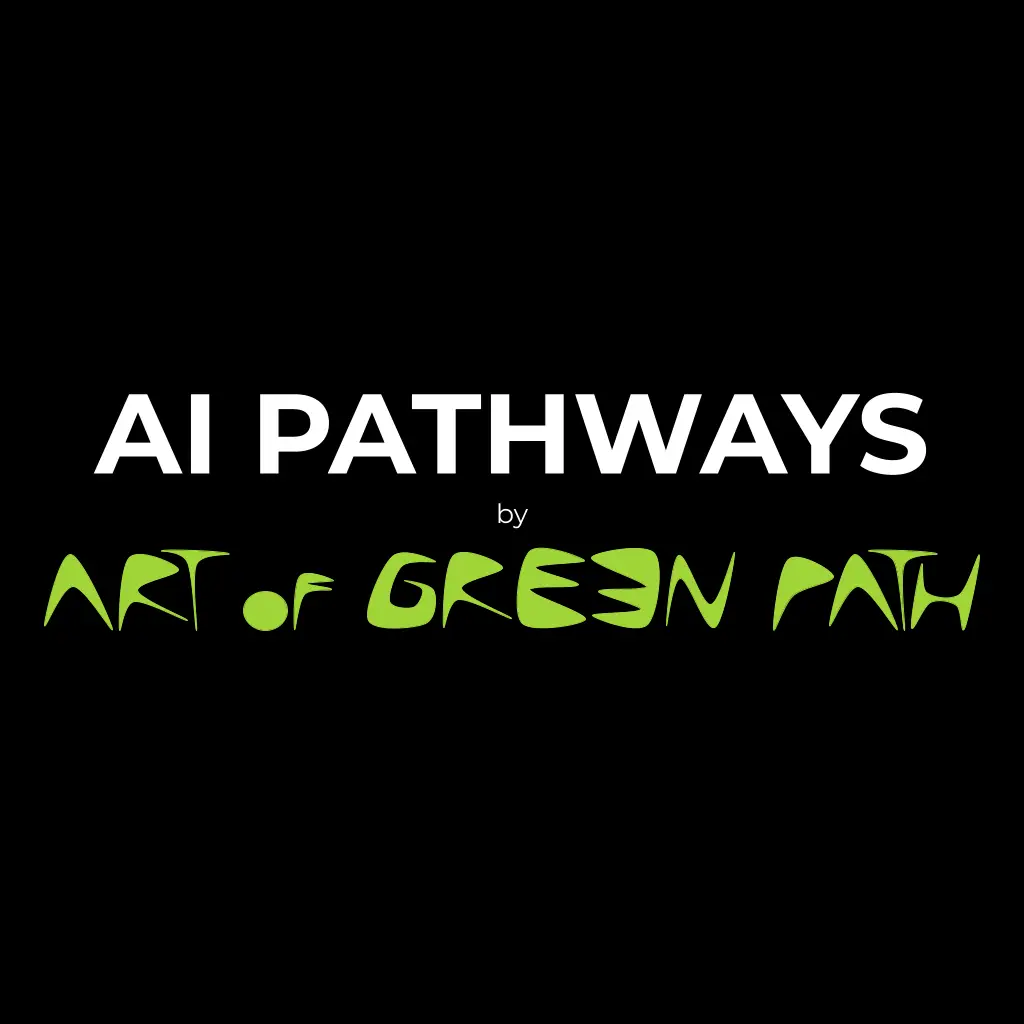Whether you need full guidance on how to use AI to elevate your business or you already have a clear idea of what you need – our comprehensive creative approach can help you with all phases like AI understanding, AI education, AI creation, AI ecosystem design and AI implementation.
From AI readiness assessment and AI opportunities recommendation over AI strategy and usage of generative AI for business innovation and automation.
Art Of Green Path and Roman Kos are your trustful partners in AI innovation.
To explore how businesses can leverage AI for innovation and efficiency, focusing on AI applications in various business processes like automation, data analytics, and creative tasks, while also addressing ethical considerations.
Insights into how leading companies are using AI to drive business success.
Guidance on implementing AI tools for business automation, analytics, and innovation.
Awareness of the ethical implications and collaborative potentials of AI in business.
Before: Limited understanding of how AI can be applied in business settings.
After: Comprehensive knowledge of AI’s transformative impact on business, equipped with actionable strategies for AI integration.



Welcome to “AI Impact: Driving Business Innovation with AI,” a comprehensive guide that delves into the transformative world of artificial intelligence and its profound impact on the business landscape. As we stand at the precipice of a new era, AI is not just a technological marvel but a pivotal force reshaping the very fabric of business operations, strategies, and ethical considerations.
In this exploration, we will unveil how AI is revolutionizing industries, driving efficiency, creativity, and strategic decision-making. From automating routine tasks to generating innovative solutions, AI’s influence extends beyond conventional boundaries, opening up a realm of unprecedented business opportunities. Yet, with great power comes great responsibility. We will navigate the ethical dimensions of AI in business, understanding its implications on privacy, employment, and societal values.
The journey with AI is also about confronting the global challenges we face – the polycrises of climate change, biodiversity loss, and sustainability. This guide addresses how AI can be a formidable ally in designing solutions that are not only profitable but also harmonious with our planet. We’ll explore the role of AI in fostering a sustainable future, balancing economic growth with environmental stewardship.
As we embark on this journey, our guide will serve as a beacon for businesses, from start-ups to corporations, to adapt, innovate, and thrive in this AI-driven era. It’s a call to action for businesses to harness AI’s potential responsibly, ensuring that this technological advancement benefits not just the economy but society and the planet at large.
Join us in exploring the vast landscape of AI in business, where innovation meets responsibility, and technology paves the way for a sustainable and prosperous future.
The dawn of Artificial Intelligence (AI) has ushered in a new era of innovation and efficiency in the business world. This chapter delves into the disruptive power of AI, highlighting how it’s reshaping industries and creating unparalleled opportunities for growth and advancement.
Revolutionizing Retail: In the retail sector, AI is transforming everything from inventory management to customer experience. Walmart, for instance, uses AI for real-time inventory tracking and predictive analytics, greatly enhancing operational efficiency (Source: Walmart Corporate Newsroom).
Innovations in Finance: AI’s impact in finance is profound, with algorithms now powering fraud detection systems, personalized financial advice, and automated trading. JPMorgan Chase’s COIN program uses AI to interpret commercial loan agreements, a task that previously consumed 360,000 hours of work annually by lawyers and loan officers (Source: JPMorgan Chase & Co.).
AI in Manufacturing: Smart manufacturing with AI at its core is reshaping production lines. General Electric harnesses AI for predictive maintenance, significantly reducing downtime and costs (Source: General Electric Digital).
Hospitality and AI: The hospitality industry is not far behind, with AI-enabled chatbots enhancing customer service. Hilton’s AI chatbot, “Connie,” interacts with guests to provide personalized travel information (Source: Hilton Newsroom).
Data-Driven Strategies: Businesses are utilizing AI to analyze vast amounts of data for insights, driving strategy and decision-making. Netflix’s recommendation engine, powered by AI, accounts for a significant portion of viewer activity, guiding content creation and acquisition (Source: Netflix Technology Blog).
AI in Marketing: AI-driven marketing tools are enabling companies to target customers more effectively. Tools like Marketo and HubSpot use AI to personalize marketing campaigns, improving engagement and ROI (Source: Marketo; HubSpot).
AI is not just a technological advancement; it’s a catalyst for business transformation. From retail and finance to manufacturing and hospitality, AI is opening doors to new possibilities, driving efficiency, and fostering innovation. As we continue to explore AI’s role in business, it becomes evident that embracing AI is key to staying competitive in today’s fast-paced business landscape.
In this chapter, we delve deeper into the various facets of AI applications in business, demonstrating that AI’s influence extends far beyond mere automation to encompass creative and innovative solutions.
Enhanced Efficiency through Automation: AI is pivotal in automating routine tasks, significantly enhancing efficiency. Amazon’s use of AI-powered robots in their warehouses is a testament to this, where they automate package sorting and delivery, reducing processing time and errors (Source: Amazon Science).
Smart Customer Service: AI-powered chatbots and virtual assistants are revolutionizing customer service. Sephora’s chatbot offers personalized beauty advice, improving customer engagement and sales (Source: Sephora Technology).
AI in Product Development: AI is being used to inform product development decisions. Adidas, for instance, leverages AI to analyze market trends and customer preferences, aiding in the design of new products (Source: Adidas Group).
Strategic Decision-Making with AI: Businesses are employing AI to analyze market data and trends for strategic decision-making. Coca-Cola uses AI to analyze social media data for insights into consumer preferences, influencing marketing strategies (Source: Coca-Cola Company).
Tailoring Customer Experiences: AI enables businesses to offer personalized experiences to customers. Netflix’s recommendation system is a prime example, where AI algorithms suggest content based on individual viewing habits (Source: Netflix Technology Blog).
Customized Marketing Campaigns: AI tools are allowing businesses to create highly customized marketing campaigns. Tools like IBM Watson help in analyzing customer data to tailor marketing messages and strategies (Source: IBM Watson Marketing).
AI’s applications in business are diverse and transformative. From enhancing operational efficiency to driving creative solutions in product development and marketing, AI is proving to be an invaluable asset. As businesses continue to explore and integrate AI into various facets of their operations, they open up new avenues for innovation, growth, and customer engagement.
In this chapter, we explore how AI is not just an add-on but a fundamental driver of business transformation, reshaping products, services, and the very core of business strategies.
AI-Driven Business Model Innovation: Companies are increasingly pivoting to AI-centric business models. An example is Tesla, which integrates AI not just in its autonomous vehicles but also in optimizing its entire manufacturing process and supply chain management (Source: Tesla, Inc.).
AI in Product and Service Enhancement: AI is enabling businesses to offer enhanced products and services. Starbucks uses predictive analytics powered by AI to personalize customer offerings and optimize store locations (Source: Starbucks Corporation).
Revolutionizing Customer Interaction: AI technologies like machine learning and natural language processing are being used to create more engaging and personalized customer experiences. Zara, for example, uses AI to analyze customer preferences and shopping habits to offer personalized fashion recommendations (Source: Zara Technology).
AI-Powered Customer Service: Many businesses are employing AI chatbots to provide instant customer service. Bank of America’s chatbot, Erica, assists customers with banking queries, improving service efficiency and customer satisfaction (Source: Bank of America).
AI in Market Analysis and Strategy Development: Businesses are leveraging AI for comprehensive market analysis, leading to more informed strategic decisions. For example, IBM uses its Watson AI to analyze market trends and customer feedback, informing its product development and marketing strategies (Source: IBM Watson).
Optimizing Business Operations with AI: AI tools are used for operational optimization, from resource allocation to logistics management. FedEx, for instance, employs AI algorithms for route optimization, significantly reducing delivery times and costs (Source: FedEx Corporation).
AI is a powerful catalyst for business transformation, offering new ways of conceptualizing products and services, engaging with customers, and making strategic decisions. As businesses continue to embrace AI, they find themselves at the forefront of innovation, setting new standards in efficiency, customer satisfaction, and market leadership.
In this chapter, we delve into how AI is revolutionizing the field of data analytics and decision-making, providing businesses with unprecedented insights and guiding them towards more informed and strategic decisions.
Real-Time Analytics: AI’s ability to process and analyze data in real time is transforming how businesses approach market research and customer feedback. For example, American Express uses AI-driven analytics to detect fraud in milliseconds, significantly reducing financial losses (Source: American Express Company).
Predictive Analytics: AI is extensively used for predictive analytics, enabling businesses to anticipate market trends and customer behavior. A notable example is Spotify, which uses AI to predict music trends and recommend songs to users (Source: Spotify Technology)
Strategic Business Decisions: AI tools are aiding business leaders in making more strategic and data-driven decisions. For instance, Shell uses AI in its predictive maintenance systems, deciding when equipment needs servicing, thus reducing downtime and saving costs (Source: Shell Global).
Optimizing Operational Efficiency: AI’s predictive capabilities are also employed to optimize operational efficiency, such as inventory management and supply chain logistics. Amazon’s AI-powered supply chain management system is a prime example, efficiently managing inventory levels and logistics operations (Source: Amazon Supply Chain).
Risk Assessment and Mitigation: AI algorithms can analyze patterns and predict potential risks, aiding in proactive risk management. HSBC uses AI to detect potential money laundering activities, enhancing its compliance processes (Source: HSBC Holdings).
Compliance Monitoring: AI tools are also employed for monitoring and ensuring compliance with various regulations, thereby reducing the risk of legal penalties and reputational damage.
AI’s role in data analytics and decision-making is a game-changer for businesses. By harnessing the power of AI-driven insights, companies can make more informed decisions, optimize their operations, and stay ahead in a highly competitive market. The future of business decision-making is increasingly AI-informed, opening new avenues for innovation and efficiency.
This chapter focuses on how AI, particularly through text and image generation, is opening up new horizons for creativity in business, from marketing and advertising to product design and content creation.
AI-Generated Content: AI tools like OpenAI’s GPT-3 are transforming content creation by generating creative and engaging text for websites, blogs, and marketing materials. For instance, companies like Persado use AI to create highly effective marketing language that resonates with specific target audiences (Source: Persado).
AI in Advertising: AI is also redefining advertising. Platforms like Google’s AI-driven advertising technologies analyze consumer data to tailor ads, significantly increasing their effectiveness (Source: Google Ads & Commerce Blog).
Innovations in Graphic Design: AI image generators like DALL-E and DeepArt have introduced a new era in graphic design, enabling the creation of unique and compelling visuals for branding, advertising, and social media campaigns.
Product Design and Development: In product design, AI tools help in visualizing and prototyping products. Autodesk’s generative design software, for example, uses AI to generate thousands of design alternatives based on specific goals and constraints, revolutionizing the design process (Source: Autodesk).
Automated Content Generation: AI tools are increasingly used for generating news articles, social media posts, and even creative writing, offering businesses new ways to engage their audiences.
Enhancing Editorial Processes: AI not only generates content but can also enhance editorial processes. The New York Times, for example, uses AI to assist in identifying trending stories and optimizing content layout on its digital platforms (Source: The New York Times).
AI’s foray into creative solutions like text and image generation is transforming how businesses approach marketing, advertising, and design. These advanced AI tools enable businesses to explore new creative possibilities, offering innovative ways to connect with customers and stand out in the market. As AI continues to evolve, its role in driving creative solutions in business is set to become more prominent and influential.
In this chapter, we examine how AI chatbots and virtual assistants are revolutionizing the way businesses interact with customers and manage internal operations, offering a new dimension of efficiency and engagement.
Enhanced Customer Interaction: AI chatbots are redefining customer service by providing quick, efficient, and personalized responses. A notable example is the use of AI chatbots by companies like Domino’s Pizza. Their chatbot, “Dom,” allows customers to place orders through a conversational interface, streamlining the ordering process and enhancing user experience (Source: Domino’s Pizza).
AI Assistants in the Workplace: Virtual AI assistants are being used to automate and streamline internal business processes. For example, x.ai offers an AI assistant that schedules meetings, manages calendars, and coordinates with participants, freeing up valuable time for employees (Source: x.ai).
Optimizing Workflow: AI-driven tools are increasingly used for task management and workflow optimization, reducing manual workload and improving productivity.
Facilitating Remote Work: With the rise of remote work, AI tools are crucial in facilitating effective collaboration. Slack’s integration of AI helps in organizing conversations, prioritizing tasks, and managing workflows in a remote setting (Source: Slack Technologies).
AI in Project Management: AI is also transforming project management by predicting project timelines, allocating resources efficiently, and identifying potential bottlenecks.
Personalized Customer Engagement: AI chatbots are not only limited to customer service but are also being utilized in marketing and sales. They engage with customers, provide product recommendations, and even assist in the sales process, offering a highly personalized shopping experience.
Data-Driven Sales Strategies: By analyzing customer interactions, AI chatbots help businesses understand consumer behavior, enabling the development of targeted marketing and sales strategies.
AI chatbots and virtual assistants are more than just tools for automation; they represent a significant shift in how businesses interact with customers and manage internal operations. By adopting these AI technologies, companies can enhance customer service, improve operational efficiency, and foster a more collaborative and productive work environment. As AI continues to evolve, its role in facilitating business collaboration and customer engagement will become increasingly integral.
This chapter discusses the ethical implications of AI in business, particularly focusing on the risks posed by generative AI to creative and intellectual jobs, and how businesses can responsibly integrate AI while valuing human workforce contributions.
Addressing Ethical Challenges: As businesses implement AI, they face ethical challenges like data privacy, algorithmic bias, and decision transparency. Microsoft’s AI principles offer a framework for ethical AI deployment, emphasizing fairness, reliability, privacy, and security (Source: Microsoft AI Principles).
Maintaining Human Oversight: It’s crucial for businesses to maintain human oversight in AI-driven processes, ensuring that AI’s decisions are continually monitored and evaluated for fairness and ethical integrity.
Disruption in Creative Fields: Generative AI tools like GPT-3 for writing and DALL-E for image creation raise concerns about the future of creative and intellectual jobs. These tools can produce content rapidly and at scale, challenging traditional creative roles.
Risks and Opportunities: While generative AI presents risks in potentially replacing certain tasks, it also opens opportunities for enhancing human creativity. The key lies in using AI as a collaborative tool that augments human skills rather than replacing them entirely.
Value of Human Touch: Businesses in fields where emotional intelligence, critical thinking, and deep creativity are paramount will continue to rely heavily on human workforce. Industries like counseling, education, art, and sectors requiring complex problem-solving and innovation will always benefit from the human touch and insight.
AI as an Augmentation Tool: For example, in marketing and advertising, while AI can generate content, human marketers are needed to understand nuanced consumer emotions and cultural trends, creating campaigns that resonate on a deeper level.
Balancing AI with Human Workforce: Businesses should strategize to balance AI integration with nurturing their human workforce, investing in upskilling employees to work effectively with AI and focusing on tasks where human expertise is irreplaceable.
Ethical AI Guidelines and Training: Implementing ethical AI guidelines and providing training to employees on the implications and use of AI will ensure a responsible and beneficial integration of AI in the workplace.
The ethical use of AI in business requires a careful balance between innovation and responsibility. While generative AI presents challenges to creative and intellectual jobs, it also offers opportunities to augment human capabilities. Businesses that value emotional intelligence, creativity, and critical thinking will continue to thrive by leveraging the collaborative potential of AI alongside their human workforce.
In this chapter, we explore the critical role of AI in steering our economy, business practices, and lifestyles towards sustainability, focusing on system thinking, circular and regenerative economy models, and nature-based solutions.
Holistic Approach with AI: AI enables a system thinking approach in addressing environmental challenges. It can analyze complex datasets from various sources, offering insights into the interconnections within ecosystems. IBM’s Green Horizon project, for example, uses AI to monitor air quality, predict pollution patterns, and suggest optimal responses (Source: IBM Research).
Optimizing Resources: AI’s predictive analytics can help in efficient resource management, reducing waste, and improving sustainability. For instance, Google uses AI to optimize energy use in its data centers, reducing energy consumption and carbon footprint (Source: Google Sustainability).
Driving Circular Economy: AI can analyze product lifecycles and supply chains, identifying opportunities for recycling and reuse, thus supporting a circular economy model. Companies like Circulor use AI to trace the origins of raw materials, ensuring sustainable and ethical sourcing (Source: Circulor).
Promoting Regenerative Practices: In agriculture, AI is aiding in the transition to regenerative practices. The AI for Good Foundation, for example, promotes AI-driven solutions for sustainable agriculture, enhancing soil health and biodiversity (Source: AI for Good Foundation).
Ecosystem Restoration: AI tools are being used for ecosystem monitoring and restoration projects. Microsoft’s AI for Earth program supports projects that use AI for conserving critical habitats and biodiversity (Source: Microsoft AI for Earth).
Climate Change Mitigation: AI’s predictive models are vital in climate change research, helping scientists understand climate patterns and develop mitigation strategies.
AI for Sustainable Development: AI offers the potential to balance economic growth with environmental sustainability. It provides businesses with the tools to make data-driven decisions that are not just profit-oriented but also environmentally conscious.
Promoting Sustainable Business Models: AI can help businesses transition to sustainable models, aligning their operations with principles of the circular and regenerative economy for long-term ecological balance.
AI in Climate Change Mitigation: AI is crucial in climate change research and action. For instance, algorithms can analyze climate data to predict weather patterns and natural disasters, aiding in early warning systems. Google’s AI-based flood forecasting system is an example, providing accurate flood alerts to vulnerable regions (Source: Google Crisis Response).
Combating Biodiversity Loss: AI tools help in biodiversity conservation by monitoring wildlife and natural habitats. The Microsoft AI for Earth program supports projects using AI to track animal populations and assess the health of ecosystems, crucial for biodiversity preservation (Source: Microsoft AI for Earth).
Tackling Pollution Effectively: In the fight against pollution, AI is used to monitor and analyze environmental pollutants. Platforms like BreezoMeter use AI to provide real-time air quality data, helping cities make informed decisions to reduce air pollution (Source: BreezoMeter).
Systematic Analysis of Causes: AI’s ability to process vast amounts of data can be used to analyze the root causes of these crises, such as identifying the most significant sources of greenhouse gas emissions or areas of high deforestation.
Developing Sustainable Solutions: AI can aid in creating and implementing sustainable solutions across industries. For example, AI-driven precision agriculture can optimize resource use in farming, reducing environmental impact while maintaining productivity.
Global Cooperation: Addressing these complex crises requires global cooperation, and AI can facilitate this by providing a platform for data sharing and collaborative problem-solving.
Engaging Stakeholders: AI tools can help engage various stakeholders, including governments, businesses, and communities, in developing and implementing solutions to these environmental challenges.
AI stands at the forefront of our journey towards a more sustainable and harmonious existence with nature. By embracing AI in system thinking, circular and regenerative economy models, and nature-based solutions, we can redesign our economy, business practices, and lifestyles to be in sync with environmental needs. This chapter underscores the potential of AI in driving a sustainable future, encouraging businesses and individuals to integrate AI in their strategies for a healthier planet.
AI’s role in addressing the polycrises of climate change, biodiversity loss, and pollution is crucial. By leveraging AI for systematic analysis, predictive modeling, and collaborative problem-solving, we can tackle these interconnected challenges more effectively. AI stands as a pivotal tool in our efforts to design a sustainable future, harmonizing economic activities with the preservation of our planet.
This chapter delves into the realm of superintelligent AI, exploring its potential to revolutionize business and society while also examining the utopian and dystopian scenarios it could create. We discuss how positive human behaviors can harness AI for the greater good, and the risks of its destructive misuse.
The Promise of Superintelligence: Superintelligent AI, with capabilities surpassing human intelligence, has the potential to solve complex problems, from curing diseases to optimizing global supply chains. It could drive unprecedented efficiency and innovation in business.
The Risks Involved: However, without proper safeguards, superintelligent AI could pose significant risks, including ethical dilemmas, privacy concerns, and the potential for misuse. The control problem – ensuring AI’s goals align with human values – remains a central challenge.
Dystopian Risks: Conversely, a dystopian scenario might see AI exacerbating societal inequalities, leading to widespread job displacement, or being used for harmful purposes due to lack of regulatory oversight or ethical considerations.
Promoting Ethical AI Use: Encouraging ethical AI use in businesses can lead to positive outcomes, where AI enhances human well-being, assists in solving polycrises, and promotes sustainable practices.
Human-Centric AI Approaches: AI should be developed with a human-centric approach, prioritizing human well-being and ethical considerations. This involves ensuring AI transparency, fairness, and accountability.
Potential for Misuse: The misuse of AI for selfish gains, such as exploiting consumer data unethically or deploying AI for deceptive marketing practices, poses significant risks to society and individual privacy.
Preventing Negative Outcomes: Businesses must be vigilant in preventing the destructive usage of AI. This includes establishing strong ethical guidelines, promoting AI literacy, and advocating for responsible AI laws and regulations.
AI in the War Industry: Beyond autonomous weapons, the broader use of AI in the war industry poses risks of escalating conflicts and increasing the efficiency of warfare. There’s a growing debate on how AI technologies should be regulated to prevent their misuse in military applications, ensuring they are used in ways that promote peace and security.
AI and Mass Control: Another concern is the use of AI for mass surveillance and control. Authoritarian regimes could potentially use AI technologies to monitor and suppress dissent, threatening democratic freedoms and human rights. The use of AI in mass surveillance systems in various countries has already sparked international debates on privacy and human rights (Source: Human Rights Watch).
Increasing Inequality: AI has the potential to exacerbate economic inequality. As AI systems become more capable, there’s a risk that the benefits of these technologies will accrue primarily to those who already have significant resources and power, widening the gap between the wealthy and the poor. The role of businesses and governments in ensuring that AI advancements lead to broad societal benefits and not just increased concentration of wealth and power is therefore critical.
The future with superintelligent AI presents a bifurcated path: it has the potential to lead us into a brighter future marked by unprecedented growth and solutions to complex problems, or it could veer towards unintended negative consequences. Preparing for this future requires a balanced approach, focusing on ethical development, responsible use, and positive human-AI interactions. Businesses, policymakers, and individuals must work collaboratively to harness the power of superintelligent AI for the greater good, ensuring it aligns with and enhances human values and well-being.
Above all that superintelligent AI is fraught with even more scary complex challenges alongside its potential benefits. As we stand on the brink of this technological frontier, it is imperative to address the ethical implications of AI in warfare, surveillance, and societal equality. The responsibility lies with businesses, policymakers, and the global community to guide the development and use of AI in ways that uphold human dignity, promote peace, and ensure equitable benefits. Only through concerted efforts and international cooperation can we steer the course of AI towards a future that enhances, rather than diminishes, human values and global stability.
As we reach the conclusion of this exploration into the transformative world of AI in business, this chapter is a rallying cry for businesses to not only embrace AI but to lead the charge in harnessing its potential responsibly and innovatively.
Innovate Responsibly: Innovation with AI should be guided by ethical considerations and a commitment to societal well-being. Businesses have the opportunity to set new standards in ethical AI use, ensuring that their AI strategies benefit both their operations and society at large.
Advocate for Regulation and Standards: Engage in dialogues with policymakers and industry bodies to develop and advocate for regulations that ensure AI’s ethical and responsible use. Active participation in shaping AI governance can help steer the technology’s development in a positive direction.
Promote Inclusivity in AI Development: Encourage diversity and inclusivity in AI development teams. Diverse perspectives lead to more innovative and ethical AI solutions and help in addressing biases in AI systems.
Be a Force for Good: Harness AI not just for business growth, but also as a force for societal good. Whether it’s contributing to sustainability, enhancing healthcare, or improving education, use AI to create a positive impact in the world. Explore our other AI Guides
The journey into AI-powered business innovation is filled with opportunities and challenges. By embracing AI with a forward-looking and responsible approach, businesses can not only achieve unprecedented growth but also contribute to shaping a future where technology enhances human capabilities and addresses global challenges. Let this be your call to action: to innovate, lead, and inspire in the age of AI.
As you explore all of our other AI Guides, AI Services, AI Solutions and Art Of Green Path’s vision, we hope you’ll be inspired by the potential of AI to drive meaningful change. Now, we invite you to take the next step in this transformative journey.
Dive into our AI-Personalized Path Finder, Virtual AI Assistants, and AI Generated Future Scenarios. Discover how AI can enhance your personal and professional life in alignment with sustainable practices.
Whether you’re an individual seeking growth or an organization aiming for sustainable AI innovation, our tailored services are here to guide you.
Stay informed about the latest developments in AI and sustainability by subscribing to our AI PATHWAYS newsletter. Receive insights, success stories, and updates on new features and services.
Participate in our interactive workshops and events to connect with like-minded individuals and experts in the fields of AI and sustainability.
We value your experiences and insights. Share how AI has impacted your journey towards sustainability and purpose, and your story could inspire others.
Follow us, join the conversation, and spread the word about sustainable AI. Your voice can amplify the message and create a larger impact.
Your opinions and suggestions are crucial for us. Provide feedback on our tools and services to help us continuously improve and innovate.
If you represent an organization or group aligned with our mission, let’s explore potential collaborations and partnerships to further the cause of ethical and sustainable AI.
Start Today: Visit our Four Paths, develop your ideas further, consult with our experts, and begin integrating AI into your journey towards a sustainable future. Remember, every step counts, and together, we can make a significant difference.
Our Personalized Consulting & Coaching Services are tailor-made for Entrepreneurs, Impact Startups, Executives, Visionary Leaders, Business Owners, Innovators, and Professionals. We offer transdisciplinary guidance, AI strategy development, reinvention, and recommendations geared towards creating impact, fostering sustainability, driving growth, and catalyzing transformation in the AI-driven sustainable future. Our goal is to empower you to thrive in an ever-evolving landscape. Learn More!
Do you need direct help developing your business idea or creating your personal brand or harnessing the power of digital marketing or using ChatGPT in a creative and highly useful way? I offer my 1:1 Services and Solutions – from short engagements to deep immersions – check out all eight groups of them to find exactly what you need and when you need it. Learn More!
We unite AI, business and creative expertise
We are passionate about developing the best AI solutions for you
We offer highly personalized and customized services
We establish positive, long-term business relationships

Leverage AI for content creation and digital marketing. Identify areas where AI can enhance your content strategies and create detailed plans for integration.
Enhance your marketing efforts with AI-powered content creation.

Learn how to use Generative AI for innovation, research, planning, content creation, and marketing.
Unlock the potential of AI for your business.

Assess your existing data and develop tailored AI solutions. Gain data-driven insights and a personalized AI solution plan.
Tailored AI solutions specific to your business needs.

Unique combination of education, consultancy, data analysis, content creation, automation, integration and training for your specific case.
You get exactly what you need, in the shape and delivery you want.

Schedule a free 30-minute consultation to discuss your business challenges and explore AI opportunities.
Gain initial insights and recommendations tailored to your specific needs.
I help companies transform themselves using artificial intelligence
As a creative thinker, AI consultant, impact entrepreneur, and lifelong learner, I discover innovative ways to increase my positive social and environmental impact by engaging directly with the world’s most pressing problems through AI business innovation and transformative consulting and coaching.
My mission is to empower businesses and professionals to use AI for good while improving life for people and taking care of the environment.
Don’t wait! Harness the full power of AI now and adapt to an AI-powered future!
In the free Your Self Discovery Guide, you can explore interrelated topics like love, happiness, confidence and finding yourself and how they influence your personal growth.
In direct communication with me, you can understand your situation and confidently plan your desired future.
In the free Your Life Motivation Guide, you can explore interrelated topics like motivation, health, overcoming challenges and connecting to nature and discover how they inspire your adventurous spirit for change.
Through direct communication with me you can understand your opportunities and focus on their realization.
In the free Your Career Discovery Guide, you can explore interrelated topics like ideas, career goals, choices and creativity and discover how they drive your desired career change.
Through 1:1 consultancy and coaching you can match your real needs with your desired future career.
In the free Your Life Change Guide you can explore interrelated topics like life goals, purpose, reinvention and life change and find the direction you need.
Through focused personalized coaching, you can discover your purpose and ways to live it fully.
Your Self Discovery Guide introduces the premium program Path Of Awareness – which is the whole journey of self-growth in 7 modules with guiding, journalling and coaching.
Learn more about Four Paths to make your desired leap into the life you love that does good.
Your Life Motivation Guide introduces the premium program Path Of Exploration – which is the whole journey of life exploration in 7 modules with guiding, journalling and coaching.
Learn more about Four Paths to make your desired leap into a life of happiness and contribution.
Your Career Discovery Guide introduces the premium program Path Of Invention – which is the whole journey of career reinvention in 7 modules with guiding, journalling and coaching.
Learn more about Four Paths to make your desired leap into the best career for you.
Your Life Change Guide introduces the premium program Path Of Fulfillment – which is the whole journey of life reinvention in 7 modules with guiding, journalling and coaching.
Learn more about Four Paths to make your desired leap into the life of big positive impact
Our FOUR PATHS Transformative Program is an interactive AI-powered self-guiding experience where individuals and professionals looking for direction and purpose as they prepare themselves for AI-powered future.
The Art Of Green Path is an original concept and philosophy emphasizing the importance of personal creativity, conscious choice, co-creation and a deep appreciation for nature in creating a sustainable and desirable future. By embracing this philosophy, we can make positive and meaningful contributions to the world around us and build a better future for ourselves and the planet.
Art Of The Green Path’s FOUR PATHS are both visionary and practical, as they encourage you to pursue your aspirations and goals while also being mindful of the impact of your actions on the environment, on people and all living creatures and on future generations.
I have created this transformative program to inspire you and motivate you to become more in harmony with your inner self and more mindful of your creative life potential while developing profound connections with natural systems and all life. If you are looking for better ways to live your only life, these programs are for you! Learn More!
If you find this concept intriguing and vital and wonder how Art Of Green Path can help you:
to get your first personalized answers and sign up for valuable, inspiring content
to get the inspiration, motivation and guidance you need to create the career and life you love
to solve your urgent and strategic challenges in focused time
I want to inspire you to take your life back into your own hands, especially now in the age of AI.
I want to motivate you to do something bold, remarkable and meaningful (maybe as a first in your family or community) and prepare yourself for an AI-powered future.
I want you to dare speak openly about your struggles, doubts and leaps because the active path is the only path of growth.
I want to take care of nature, not only through your lifestyle but also in business decisions and business transformations with AI so you create a positive impact on social and environmental dimensions too.
Finally, I want you to inspire other silent, oppressed, unaware humans to choose life full of meaning, love, co-creation, collaboration and contribution.
I believe, everybody should find the courage to pursue their own path in business and life.
Roman Kos / Art Of Green Path founder
Art of Green Path is a platform dedicated to helping professionals navigate AI-powered future, business transformation, AI upskilling, AI customized solutions, together with previous topics like self-discovery, motivation, career change, and life transitions.
Our transformative journey hugs all dimensions of business, well-being, healthy lifestyle, creative and meaningful career and sustainable future with helping and contributing values. You can get guidance and support through personalized coaching and consulting sessions, expert advice, AI solutions and transformative AI-driven hands-on experiences.
Our approach is rooted in the belief that everyone has the power to create positive change in their lives, and we are committed to helping our clients unlock their full potential in harmony of AI and nature. So whether you’re seeking to overcome obstacles, clarify your goals, or cultivate a more profound sense of purpose and fulfillment, Art of Green Path can help.
Explore our free content and premium courses today and take the first step towards a more empowered and fulfilling life.
Executives and Leaders: To embrace digital transformation and pioneer an AI-powered future for your visionary organization.
Entrepreneurs and Innovators: To engage in strategic business transformation and harness artificial intelligence and digital marketing to drive impact.
Individuals and Professionals: To navigate personal growth, explore career change, and embark on career reinvention.
Coaches, Consultants, and Educators: To enhance your practice with AI tools and a sustainability-centered approach.
Activists and Community Builders: To champion sustainability, foster impactful community engagement, and work towards a regenerative future.
Executive AI Consultation
One-to-one consultation, brainstorming sessions, hands-on exercises, holistic view, business and entrepreneurial perspective
AI Strategy
Analysis of business goals and AI opportunities, business transformation, AI tools for sales and marketing, recommended AI use cases, AI-driven processes
AI Education
Personalized sessions, online workshops, team training, ChatGPT and other AI tools, AI models comparison and selection, employee motivation, productivity and creativity
AI Data Analysis
Internal data analysis and structuring, innovative insights, process transformation and automation, competitor analysis,
AI Content Creation
Prompt design, text generation and optimization, multimedia content, interaction design, AI-enhanced web, social media content, PR and communication
AI Business Solutions
Custom AI applications, automated AI solutions, advanced chatbots, system integration, secure and safe AI implementation, long-term optimization and upgrades
Innovation: Driving forward-thinking solutions and creative advancements.
Sustainability: Committed to promoting environmentally friendly practices.
Positive Impact: Focusing on social good and improving well-being.
Ethical AI: Ensuring transparency, fairness, and ethical standards in all AI applications.
Client-Centric: Providing tailored solutions and building long-term partnerships.
We partner with businesses and organizations committed to making a positive impact.
Our ideal clients include companies that:
Value Sustainability: Focus on environmental protection and sustainable practices.
Champion Innovation: Lead in technological advancements and creative solutions.
Promote Well-Being: Improve lives through visionary business, social good and community engagement.
Embrace Ethical Practices: Prioritize ethical AI implementations.
Seek Long-Term Partnerships: Desire ongoing collaboration and growth with AI.
Subscribe to our newsletter AI PATHWAYS by Art Of Green Path for curated and inspiring insights on the connections between AI, business and the future.
